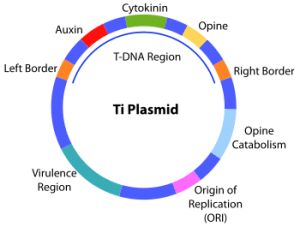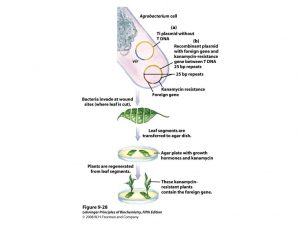- Agrobacterium mediated t-DNA transfer is widely used as a tool in biotechnology.
- In genetic engineering the tumour promoting and open synthesis genes are removed from the t DNA and replaced with the gene of interest and selection marker which is required to establish which plants have been successfully transformed.
- Selection markers include phosphotransferase ,hydromycin be phosphotransferase and poly HNO3 acid acetyl transferase.
- Agrobacterium is then used as a vector to transfer the engineered t-DNA into the plant genome.
- Genetic material transfer from A. The first reported case of successful horizontal gene transfer from prokarya to eukarya is tumefaciens and associated species with their host plants.
- This method can be used to generate transgenic plants carrying a foreign gene.
- Naturally transmitted T-DNA sequences by many Agrobacterium spp. They contain two kinds of promoter-controlled genes associated with expression in eukaryotic cells. The first set of genes (oncogenes) encodes proteins that cause growth regulator biosynthesis or plant cell reaction (auxins and cytokinins) and induce unregulated cell division, resulting in tissue proliferation and neoplastic growth (crown gall) development.
Mechanism
- The first step in integrating the t DNA into a host genome is the formation of nick at the right border of the ti plasmid.
- This neck create a reason of single stranded DNA from the left border of the t DNA gene over to the right border which was cut.
- Single stranded binding protein then attached to the single stranded DNA.
- DNA synthesis will displace the single standard reason and then the second nick at the left border reason will release the single stranded DNA fragment.
- This fragment can then be incorporated into a host genome.
Uses in mutagenesis:
- By insertional mutagenesis, the same method t DNA transfer may be used to disrupt genes.
- The inserted t DNA sequence not only produces a mutation, but also allows the affected gene to enable its isolation.
- This technique is commonly used in plants such as aralridopsis thaliana, a model plant, to study gene expression.
- The introduction of a DNA into plants has enormous implication for agriculture making possible the alteration of the nutritional profile for yield of their resistance to environmental stress such as insect ,pest ,disease

Basic ideas about vectors for plants:
- Fertile plants of some species may be generated from a single transformed so that can introduce gene passes to progeny through the seeds.
- Researchers have not found any natural plant cell+ developed to promote cloning into plants, showing that the technological difficulty is to bring DNA into the plant cell.
- The soil bacterium agrobacterium tumefaciens is an important initiative.
- At the wound site, this bacteria can turn almost cells into inward plants and cause them to a shape of tumour called a crocon gall.
- The great ti plasmid contains agrobacteria.
- A 32,000 BP fragment of the ti plasmid labelled t DNA is converted from the plasmid when the bacterium is in contact with the damaged plant cell and inserted into one of the plant cell chromosomes at a random location.
- DNA encodes an enzyme that converts plant metabolites into two types of bacteria-friendly compounds.
Transfer of DNA to plant cell by a bacterial parasite
- The first is a ti plasmid that was extracted in the laboratory from the t DNA section.
- The second is the shuttle vector of agrobacterium e coli in which the 25 BP repeat of a foreign gene’s t DNA flask that the researcher wants to insert into the plant cell along with the selectable marker such as antibiotic kanamycin resistance.
- By growing on agar plates containing kanamycin, the transformed plant cells can be selected and the incorporation of growth hormone induces the development of new plants containing a foreign gene in each cell.
- The efficient transition of our DNA into a plant was demonstrated by the agreement that the Syrifireflies luciferase genes were inserted into the wall of a bride plant tobacco plant for transformation since it is especially easy to convert cells with agrobacteria.
- Of course, the promise of this technology is not limited to the manufacture of glow-in-the-dark plants.

References
